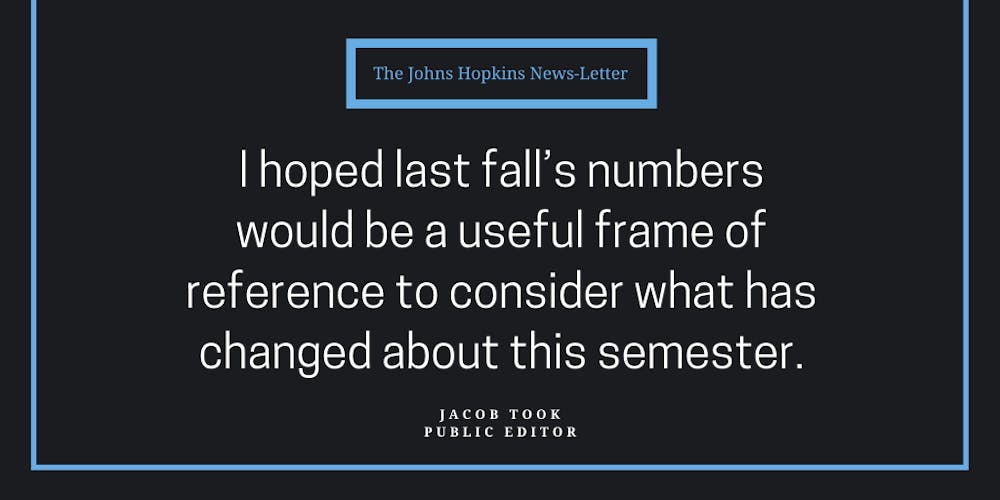
When I started recording data on the number of different types of perspectives represented in The News-Letter, I wanted to give editors a benchmark to measure the scope of each week. That’s not to say they should always strive to increase these numbers — at some point, the paper will reach critical mass and just be too full. Instead, I hope it can offer a new way to track coverage from one week to the next.
That said, I was curious to find out whether the numbers, particularly on undergraduates, would reflect an upward trend. There is a general increase, but not conclusively so — last week saw the fewest undergraduates so far this semester. Still, the surface level of this data fails to capture the shift of which sections carry undergrads.
Case in point: on the semester’s first spike of 78 in the October 3 issue, News & Features alone had 50 undergrads. At the highest peak of 82 in the November 7 issue, though, the section only included 36 (still on the higher end, but much closer to the typical number). On November 7, other sections demonstrated significant efforts to represent more undergrads, with Arts & Entertainment and Science & Technology (SciTech) both more than doubling their averages.
So while there wasn’t exactly an upward explosion, this semester’s data reflects a gradual shift toward more sections including a broader range of perspectives. Certainly, the influence of other sections in representing a broader range of perspectives, most notably undergrads alongside grad students and professors, has contributed to an average increase over last fall in all four categories.
I didn’t draw up a comparison between my data on this semester and that of last fall to create a smackdown between the editors from last year and this year. Instead, I hoped last fall’s numbers would be a useful frame of reference to consider what has changed about this semester.
In terms of the number of community members, as well as professors and graduate students, other sections did more of the leg work this semester than I ever remember seeing before. This comes through most clearly regarding the number of professors and graduate students, which I was surprised to find increased on average from last fall.
A couple of major stories really kept last year’s news editors busy — the private police force and its accompanying protests, as well as the efforts of Hopkins nurses to unionize. (Here I have to explain that I use ‘professors and grad students’ as a general category which sometimes includes staff like dining workers or nurses at the Hospital). Reporting these stories pushed the average count of professors and grad students in last fall’s news coverage above this semester’s.
So I was surprised to find that the average number of professors and grad students (and staff) still increased for the paper overall from last semester. That is, I was surprised until I realized that other sections, most notably SciTech, have stepped up their reporting game to reach new audiences and coverage new stories that previously, for one reason or another, fell outside the paper’s scope.
Last fall, fluctuations in the number of perspectives featured in news coverage heavily determined the overall paper’s week-to-week variations. This semester, though, that was really only true of the number of administrators (news reporters profile new admin and grill others as-needed, but admin hardly ever appear in other sections).
While the average number of admin increased over last fall,though, the data shows a proportional decrease relative to the number of undergrads, meaning the ratio of undergraduate students to administrators has increased. Last fall saw an average of about 53 undergrads and six admin per issue, or a ratio of just under 9:1. This semester, though, the undergrad average rose to about 61, while the admin average still rounds to six (now it rounds down instead of up), for a ratio of over 10:1.
I’m sure this also comes down to other sections representing a broader range of perspectives, and it’s also worth noting that last fall featured a generally smaller pool of admin — University President Ronald J. Daniels himself appears quite often, speaking at forums on the police force and commenting for stories like Michael Bloomberg’s $1.8 billion donation.
As the number of undergrads featured in the paper increases, so will the ratio of undergrads to admin — at some point, there’s only so many stories that require a comment from an administrator, but I would never argue against including an undergraduate, no matter what the nature of the story was.
Given the paper’s mission to represent Hopkins undergraduates, editors should aim to see that number climb. This semester, the paper hit comfortable average of 61, increased by eight from fall 2018. But any given issue from this semester could have as many as 82 — or more! It’s possible to keep growing. Let’s see what next semester brings.
We want you to be part of this conversation! We encourage our readers to email publiceditor@jhunewsletter.com with questions or comments about our practices and published content.





